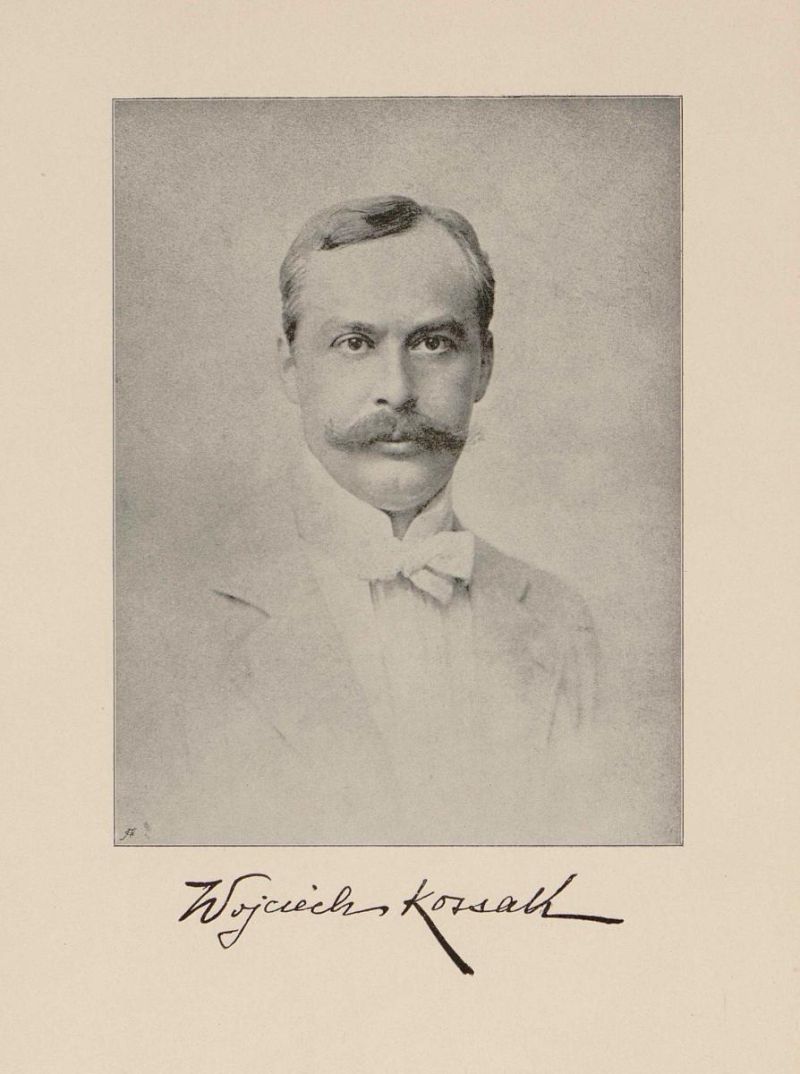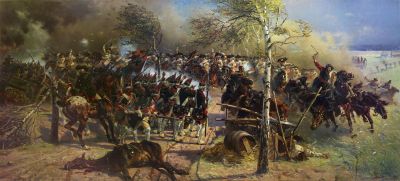Wojciech Kossak: Memoirs, 1913












In contrast to the Polish edition (see PDF 1) the German edition appeared without the illustration on the binding, but as a half leather volume with marbled book covers and leather corners (see PDF 2).[1] With the exception of a few changes in the chapter structure, the two editions appear to differ only slightly. They are illustrated throughout with 92 (90) black-and-white illustrations, namely contemporary photographs, reproductions of paintings, as far as they belong to the textual context, and watercolours and sketches created especially for the book, as well as with 8 (9) colour plates again based on oil paintings by the artist. Both editions are dedicated to his mother, Sophie von Kossak/Zofia z Gałczeńskich Juliuszowa Kossakowa, and to his wife, Marie von Kossak/Marya z Kisielnickich Wojciechowa Kossakowa, "the two Polish ladies who knew how to be women artists. Today the volumes are available in at least one hundred libraries worldwide.r.[2] The manuscript can be found in the National Library/Biblioteka Narodowa in Warsaw in the Wojciech-Kossak-Archive/Archiwum Wojciecha Kossaka.[3]
Wojciech Kossak[4] was born on New Year's Eve 1856 in Paris, his twin brother Tadeusz (1857-1935) shortly thereafter in the New Year. During his law studies in Lviv his father, Juliusz Kossak (1824-1899), had studied painting at the private painting school owned by the portrait and genre painter Jan Maszkowski (1793-1865), and had already become a portrait, hunting and horse painter at a young age. After his marriage he went to Paris in 1855, where he studied museum collections, maintained close relations with the battle painter Horace Vernet (1789-1863), worked with a group of Polish painters led by Wojciech Gerson (1831-1901) and where his sons Wojciech, Tadeusz and Stefan were born. From 1861 to 1868 Juliusz Kossak was the artistic director of the magazine Tygodnik Illustrowany in Warsaw. In 1868/69 he resumed his studies in Munich for about ten months in the private studio of the battle painter Franz Adam (1815-1868), where he had intensive contact with the Polish painters Józef Brandt (1841-1915) and the brothers Aleksander (1850-1901) and Maksymilian Gierymski (1846-1874). Back in Poland he settled with his family in Krakow and became known as a painter of historical and battle scenes, a watercolourist and illustrator.[5]
Horace Vernet became Wojciech's mentor, "a kind of kinship between two painter dynasties that is still unique in art history," as Kossak writes (German edition, p. 3). His earliest memoirs are dedicated to the soldiers on the forecourt of the Hôtel des Invalides in Paris, where war-wounded soldiers, illustrated in a painting from 1912, are looking into the pram of the little Wojciech and posing with his Masurian nanny (Fig. 1). His father had contacts with old Polish politicians who had emigrated to France, and officers of the Polish army like Prince Adam Jerzy Czartoryski (1770-1861), head of the Polish revolutionary government of 1830, and General Władysław Zamoyski (1803-1868), his close confidante. For the father, "these long-gone types of soldiers were an inexhaustible source of study" (p. 7), the stories of old gentlemen that he presumably recounted later. For the child, they were exciting episodes from the infernal world of war.
The start of the "childhood years in Warsaw 1863-1866" for the five-year-old was marked by crowds of wild horsemen wearing huge fur caps, scimitars and long pistols. During the January Uprising, they galloped past the balcony of his parental home from Neue-Welt-Straße/ul. Nowy Świat to the suburbs of Krakow/Krakowskie Przedmieście (p. 24), a scene that Kossak illustrates in watercolours that he also painted in 1912 (Fig. 2). The twins narrowly escaped a bomb attack on the Russian governor, Friedrich von Berg (1794-1874). Numerous relatives joined the uprising. There were denunciations and apartment searches, from which the Kossak family was not spared. Arrests, deportations of exiled persons and public executions soon became part of everyday life in Warsaw. At the grammar school, Wojciech sketched battles, horses and armed cavalry. When Russian was introduced as the official teaching language in 1867, the Kossaks moved to Krakow to have their children educated at Polish schools (p. 32).
[1] Made available to the Boston Public Library by the non-profit Internet Archive in San Francisco https://archive.org/details/wspomnienia00koss/page/n9. A new edition has also been published: Kazimierz Olszański (editor): Wojciech Kossak. Wspomnienia, Warsaw 1971. The German edition is available as a PDF download from the library of the Kunsthistorisches Institut der Freien Universität Berlin, https://refubium.fu-berlin.de/handle/fub188/21436. The cover of this copy is certainly original, as the same items are also available in antiquarian bookshops. The present copy was looted from the property of the Jewish Viennese industrialist Eugen Herz (1875 Vienna - 1944 Rimsting), http://lootedculturalassets.de/index.php/Detail/Object/Show/object_id/241231. As part of the National Socialists' "aryanisation measures," his house in St. Gilgen was confiscated in April 1938 and his library "secured". Due to a serious illness, Herz himself was at that time on a cure at Lake Chiemsee, where he died in 1944. His library was released for sale by the National Socialist authorities in April 1940 ( “Buchraub in Salzburg. Bibliotheks- und NS-Provenienzforschung an der Universitätsbibliothek Salzburg”, edited by Ursula Schachl-Raber and others, Salzburg 2012, page201-203). The present "Memoirs" by Kossak belonged to the library of Dr. Eugen Herz as evidenced by the ex-libris glued to the inner cover and created in 1923 by the Viennese artist Richard Lux (1877-1939).
[2] WorldCat lists the Polish edition worldwide in 64, the German edition in 30 important scholarly librarie, https://www.worldcat.org
[4] cf. On this portal the biography of Wojciech Kossak in the Encyclopaedia Polonica, https://www.porta-polonica.de/de/lexikon/kossak-wojciech, and the article by Axel Feuß: Wojciech Kossak: Schlacht bei Zorndorf (1758), 1899, https://www.porta-polonica.de/en/atlas-of-remembrance-places/wojciech-kossak-battle-zorndorf-1758-1899
[5] Andrzej Ryszkiewicz: Fortunat Juliusz Kossak, Internetowy polski słownik biograficzny, https://www.ipsb.nina.gov.pl/a/biografia/fortunat-juliusz-kossak






















































































